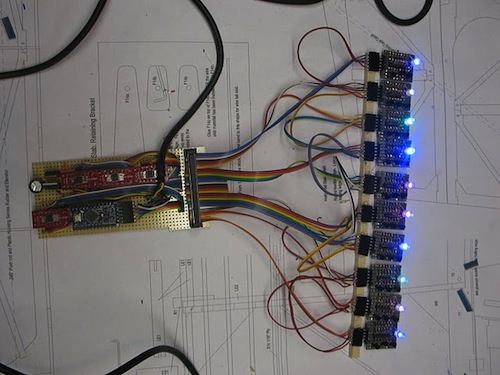Many of us at SparkFun are not only interested in embedded electronics, but also have a love for RC airplanes. So this project from SparkFun customer Tom Hastie strikes especially close to home. Check out the Night Flyer!
Besides having a sweet name (Night Flyer!), this project is very cool from an electronics standpoint. Essentially, Tom is using an Arduino Pro Mini to control four daisy-chained MAX6966 LED driver chips over SPI. The MAX6966s each have 10 channels of PWM control, so with 4 chips, he has a total of 40 channels (or 13 different RGB channels). He uses our SSOP 16-pin breakout so he can use a protoboard to wire up all his parts. What I'm trying to say is that Tom has control over a lot of different cool colors. The result is a pretty awesome airshow!
Tom does a great job of documenting his build so you check out his build log plus a whole bunch of videos like his breadboard with only 1 RGB channel, his prototype circuit with 10 RGB channels, and his completed aircraft flight demo (my personal favorite). Great work, Tom!







Sweet... I made the Sparkfun page!
Believe it or not, I have had the authorities called on me. Someone reported a UFO or a plane crash or something when I was flying my smaller nightflyer from a soccer field near my house.
The fact that I needed to carry a bunch of extra weight was factored into the choice of airframes. The model kit is actually from another awesome Colorado company, http://www.stevensaero.com/ His kits are always built super light so you can load them up with extras and still have them fly well.
Oh, and long exposure pictures of night flyers is one of my favourite things:
https://picasaweb.google.com/lh/photo/J8iz6S38DsixtBAPjYL6qA?feat=directlink
https://picasaweb.google.com/tom.hastie/ScaleAerobaticsNationals#5100600749583279506
https://picasaweb.google.com/tom.hastie/ScaleAerobaticsNationals#5100600431755699362
From an RC pilot and a geek who's in love with LED's, that is one heck of a job, very nice!
Yeah, UFO was the first thing I thought of when I saw this. How many times has this plain gone up and how many people thought it was a UFO? Great plain. You don’t have about 12 of these and are secretly flying them over New Mexico?
Wow! You're right! These are nice kits! We didn't have kits like this when I was younger (And into model planes).
Hmmm.....
By the way, congratulations on the new tutorials page!
Thanks :) It's still a work in progress, but it's getting better!
You guys should put them in order from most visited to least visited.
I like it!
Just add a long-exposure camera for a flying POV rig...
It would be even cooler if you had a scanning laser on board! Imagine massive disks of light swinging around mid-air! Spectacular on a slightly misty night.
Nice Project!
Great job, Tom. The work you have done on this looks professional and well thought out. Keep up the good work.
This is what happens when you got nothing to do :D
I want one of those :P
Very cool! I'd like to humbly suggest an investigation into the ShiftPWM library and a bunch of 74hc595's, which could be had for 0.75-1.50 a piece. They come in a dip package which could make prototyping and board production easier. The only downside I can see currently is that it would require one extra chip over the 4 needed for the max chips.
Edit: You can find the library for it here:
http://www.elcojacobs.com/shiftpwm/
As a tradeoff - the NXP PCA9635 has higher port density and lower cost. Main disadvantages:
1) Needs current limiting resistors (but so does the 595)
2) It's surface-mount only (but compatible with Sparkfun's SSOP breakouts)
Major advantage: High-rate PWM done by the hardware, which offloads the software in the controlling AVR.
Basic example code for driving it using an AVR is at https://github.com/Entropy512/DMX_PCA9635
The above will work with Arduino-compatible hardware, however, I use straight avr-gcc and not the Arduino IDE. Obviously in this case the DMX reception code can be torn out.
Another option you could investigate are prebuilt WS2801 nodes controlled by an AVR.
Hey thanks for pointing out that library. I think the main reason I didn't use the shift registers was that I didn't know that library existed. I might look into that if I ever build it again, or if I decide to try to make a proper PCB of the board. Definitely cheaper than the $5 the 6966 chips cost at digikey.
On the other hand, two of those Max6966es are "Free Samples" from their website ;) Don't forget to use that trick when you can.
Let the UFO sightings begin!
I'm surprised you can put that much stuff in that small a plane and still have it fly.
This message has been brought to you by Nocturnal Aviation, a wholly owned subsidiary of Fly By Night Industries.
Yep, definitely going to generate UFO calls. It's just given me an idea for a project that I likely will never get the time to do. sigh Excellent work, though!